
Did you know that 90% of companies have some kind of customer loyalty program?
However, most loyalty program members aren’t actively participating in them. Research by McKinsey shows that on average, customers belong to 17 loyalty programs, but less than 50% actively engage in them.
Clearly, there’s more to building customer loyalty than setting up a program. In order to drive engagement and repeat purchase, your rewards program should truly provide a… well, rewarding experience.
Which is exactly what we’ll discuss in this article. We’ll cover:
- What is customer loyalty?
- What is a customer loyalty program?
- Why having a loyalty program is important
- What are the different types of loyalty programs?
- How loyalty programs work
- What are good customer rewards
- How to create a successful loyalty program
- Top loyalty program metrics to track
- How to set up a rewards program
- Examples of loyalty programs
Turn more window shoppers into buyers
Gone are the days when “May I help you?” met with an enthusiastic response. Today, retailers need to find creative ways of capturing the attention of those wandering into their store. This guide shows you how.
What are customer loyalty programs?
Customer loyalty is the tendency of customers to repeatedly purchase products or services from a particular business over time. It indicates a strong and ongoing relationship between the customer and the merchant.
Rory Moss, Chief Revenue Officer at Marsello defines it best:
“Customer loyalty is a relationship with your business. It’s those positive interactions you have with customers every day and the relationships that build from them that create value.”
It’s worth noting that customer loyalty is NOT your loyalty program. A program is a tactic you can use to build loyalty, but if you’re not offering value to begin with, the program itself won’t be very successful.
Did you know? We did a webinar with Marsello that walks merchants sheds light on customer loyalty and what brands need to do to succeed. Catch it on demand below.
What is a customer loyalty program in retail?
A customer loyalty program (aka rewards program) is a structured marketing strategy that’s designed to reward and incentivize customers for their loyalty and repeat purchases.
Customer loyalty or rewards programs come in different forms, but the general premise remains the same: customers are offered perks, benefits or rewards in exchange for their purchases and support.
What are the different types of loyalty programs?
The most common types of loyalty programs are:
Points-based programs
In this type of program, customers earn points for their purchases, and these points can be redeemed for rewards, discounts, or free merchandise. The more customers spend, the more points they accumulate. This then unlocks more (or higher-value) rewards, which they can use on future purchases.
Here’s a great example of a point-based loyalty program from Brandini Toffee in Palm Springs, CA.
Customers earn 1 point for every $1 purchase, and they can use those points to get discounts on future purchases. 100 points gets them $10 off, 200 points unlocks $20 off and 300 points unlocks $30 off.

Tiered programs
Tiered loyalty programs divide customers into different levels or tiers based on their spending or engagement levels. Each tier offers increasingly valuable rewards and benefits, motivating customers to progress to higher tiers by increasing their loyalty.
Nordstrom’s The Nordy Club is one example of a tiered-based structure. The program has three levels—Member, Influencer and Ambassador—and customers unlock more benefits, the higher they move up in the program.
For instance, the highest tier (Ambassador) gives people access to exclusive style events and in-home styling.

Punch cards
Popular in small businesses or cafes, punch cards provide shoppers with a physical card that gets stamped or punched each time they make a purchase. After a certain number of punches, customers receive a free item or a discount.
Here’s an example of what that can look like:

Level up your loyalty program
Punch cards are simple but cumbersome to use. Level up your rewards program with Lightspeed Advanced Marketing. Lightspeed offers all the tools you need to increase shopper loyalty and drive repeat sales. Connect with customers in-store and online and create delightful shopping experiences at every touch point.
Paid membership programs
Some brands offer premium, paid membership programs that provide exclusive benefits and perks to members. These programs often include features like free shipping, early access to sales, personalized offers, or enhanced customer service.
The most well-known example of this is Amazon Prime. Subscribers enjoy an array of benefits, such as free two-day shipping on eligible items, access to a vast library of streaming content, exclusive discounts, early access to sales like Prime Day, and even perks like Prime Music and Prime Reading.
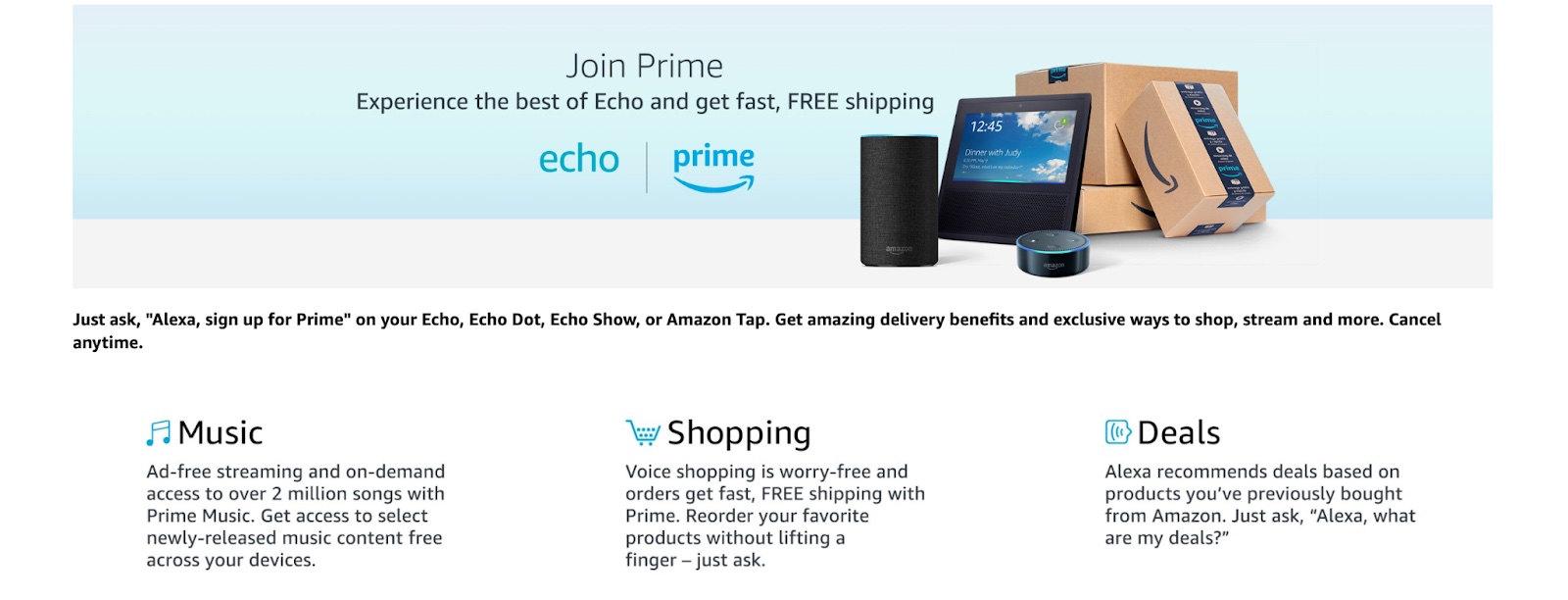
Value-based programs
Value-based customer loyalty programs for retail are designed to align with the values and preferences of your customers, rather than simply offering discounts or points for purchases.
These programs often involve charitable donations or support for social causes whenever a customer makes a purchase. For example, a portion of each sale might be donated to a charity that aligns with the brand’s mission or values. This type of loyalty program appeals to customers who prioritize ethical consumption and social responsibility.
Partnered program
Partnered loyalty programs in retail involve collaboration between two or more businesses to offer shared rewards to their customers. In this type of loyalty program retail, customers can earn points or benefits when shopping across a network of partnered brands.
For example, a clothing retailer might partner with a popular coffee shop, allowing customers to earn points at both locations and redeem them for rewards at either business.
This approach broadens the value of the loyalty program by offering customers more ways to earn and redeem rewards, thus increasing their engagement with all partnered brands. It also allows businesses to tap into each other’s customer bases, expanding their reach and driving cross-promotion.
Game program
Game-based, also known as gamified, customer loyalty programs for retail add an element of fun and engagement by incorporating gamification into the shopping experience.
Customers earn rewards by completing specific actions or challenges, such as making a certain number of purchases, visiting the store frequently, or participating in special promotions. These challenges are often designed to be engaging and entertaining, making the loyalty program feel like a game rather than a traditional rewards system.
Hybrid Loyalty
Hybrid loyalty programs combine elements from various types of loyalty programs to create a more comprehensive and versatile customer loyalty program for retail.
These programs may include a mix of points-based rewards, value-based incentives and gamified elements, allowing retailers to cater to a broader range of customer preferences and behaviors.
For example, a hybrid loyalty program might offer points for purchases, opportunities to earn extra rewards through challenges and value-based benefits like charitable contributions.
Why is having a customer loyalty program important?
Implementing a customer loyalty program is important for several reasons.
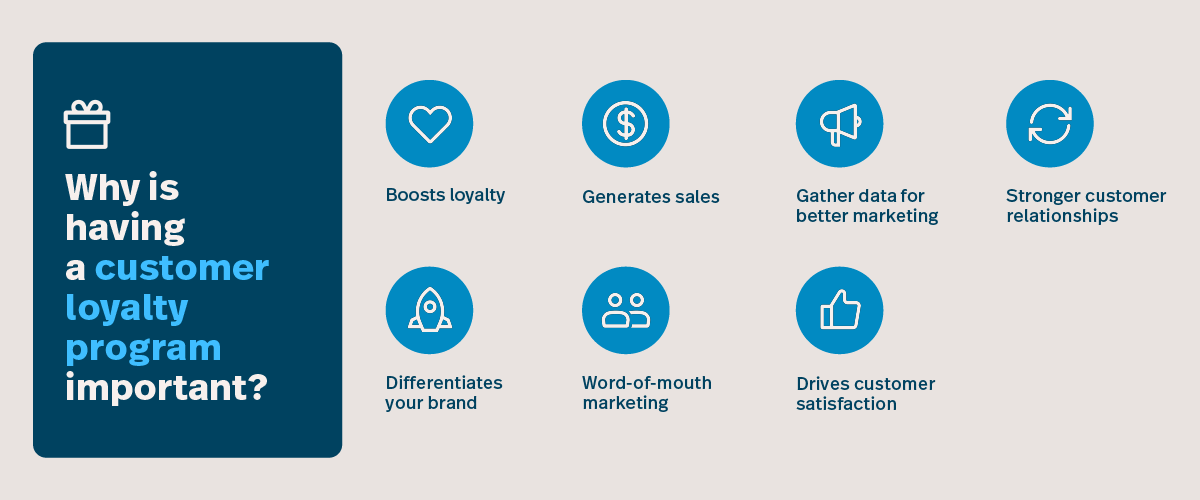
1. Boosts loyalty
First, a rewards program builds customer loyalty by encouraging repeat purchases. By giving customers a goal to work towards, such as reaching the next reward, they associate their purchases less with spending money and more with earning a prize.
Research shows that when applied to a retail setting, gamification can boost repeat visits by 30% on average.
2. Generates sales
Second, rewards programs help you generate more sales. Loyalty programs, by design, encourage shoppers to purchase more frequently, and this naturally leads to higher revenues.
3. Gather data for better marketing
Last but certainly not least: loyalty programs give you valuable insights into your customers.
“Arguably one of the most important aspects is about getting a better understanding of your customer base, so you can better tailor your marketing mix,” says Rory at Marsello.
“Without that data, you have a fragmented view of your customer base. So you might be making decisions about how you’re pricing or merchandising your store sometimes based on assumptions.”
He continues, “We often find when we deal with retailers is once we give them access to the loyalty data. They’re actually quite surprised at the insights and information about their existing customer base.”
4. Stronger customer relationships
A well-designed retail customer loyalty program fosters stronger relationships by consistently rewarding customers for their patronage. Over time, these strengthened relationships lead to increased loyalty, as customers are more likely to return to a retailer that recognizes and rewards their ongoing support.
5. Differentiates your brand from competitors
In a crowded market, a loyalty program for retailers can be a powerful differentiator.
By offering unique rewards and experiences through a reward point system for customers, a brand can stand out from competitors who may not offer the same level of engagement. Retail customer loyalty programs that offer exclusive perks, such as early access to sales or special discounts, provide customers with compelling reasons to choose one brand over another.
6. Word-of-mouth marketing
Retail customer loyalty programs often inspire customers to share their positive experiences with others, leading to valuable word-of-mouth marketing. When customers feel appreciated and rewarded through a loyalty program for retailers, they are more likely to recommend the brand to friends and family.
Additionally, some programs offer referral bonuses, further incentivizing customers to spread the word.
7. Drives customer satisfaction
Retail customer loyalty programs can directly contribute to customer satisfaction by rewarding shoppers for their purchases and engagement.
A well-structured reward point system for customers ensures that they receive meaningful benefits, such as discounts, special offers, or exclusive access to events. These rewards not only enhance the shopping experience but also make customers feel valued and acknowledged.
How do customer loyalty programs work?
The short answer is it depends. The specific mechanics of loyalty programs will vary depending on the type of initiatives in place.
How points-based programs work
Points loyalty programs allow customers to earn points for their purchases, which can be accumulated and later redeemed for rewards. Customers receive a certain number of points based on their spending. These points can be exchanged for discounts, free merchandise, or other incentives.
The more customers spend, the more points they accumulate, unlocking higher-value rewards. Points loyalty programs incentivize continued patronage and provide shoppers with a tangible benefit for their loyalty to the business.
How tiered programs work
In tiered loyalty programs, customers are categorized into different levels or tiers based on their spending or engagement. Each tier offers increasingly valuable rewards and benefits.
Customers start at a base level and progress to higher tiers by meeting specific criteria, such as reaching a certain spending threshold. The benefits and rewards become more enticing as customers move up the tiers, providing an incentive for continued loyalty and increased engagement with the retailer.
How punch cards work
Punch card loyalty programs typically involve customers receiving a physical card that gets stamped or punched each time they make a purchase.
After a certain number of punches or stamps, the customer becomes eligible for a free item, discount, or other reward.
Punch cards are a more traditional way to run a loyalty program. These days, you’re much better off using a solution like Lightspeed Advanced Marketing which automates and streamlines earned rewards and redemption.
No need to fumble with physical cards—so your team and staff will thank you.
How paid memberships work
Paid membership loyalty programs require customers to enroll and pay a fee to gain access to exclusive benefits and perks. Members usually enjoy advantages such as free shipping, early access to sales, personalized offers, enhanced customer service, and special events.
The membership fee contributes to additional revenue for the retailer, while customers feel valued and receive premium treatment in return. Paid membership loyalty programs create a sense of exclusivity, fostering loyalty among members and incentivizing continued engagement and purchases.
What are good customer rewards?
Not sure what kinds of rewards to provide? These are some of the most popular rewards businesses make available to loyalty program members:
- Discounts: For example, you could offer 50% off one item, or $10 off the next purchase.
- Gift cards: Provide digital or physical gift cards that customers can use online or in store in exchange for points.
- Products: Take inspiration from the classic coffee shop punch card model, which usually gives customers a free cup of coffee after they’ve purchased a certain number.
- Collectible items: Give away branded merchandise or products that are available exclusively to loyalty members.
How to create a successful loyalty program
Now that we’ve talked about the fundamentals of loyalty programs, let’s discuss how you can maximize the success of your initiatives.
Incorporate these best practices into your rewards program so that customers want to sign up and continue to engage in the program.
Keep it simple
There are many ways to reward your customers, and while it’s tempting to introduce several bells and whistles, we recommend keeping things simple.
“Too many earn rules result in a term called ‘loyalty confusion,’ where your customers don’t understand how your rewards program works,” explains Rory.
That’s why he advises merchants to implement an easy-to-understand structure like 1 point = $1.
Start small
You may have many ideas for perks and loyalty events—and that’s great! However, resist the temptation to unload them all at once. Stagger your initiatives so have a steady flow of campaigns throughout the year.
As Rory puts it, “you want to ensure your marketing team has a constant stream of new things to shout about.”
“Keep your program fresh by introducing new rewards, double points days or VIP tiers [over time].”
Provide value for your customer
A successful loyalty program must offer real value to its participants.
This means understanding what your customers genuinely appreciate and need from your services or products. Whether it’s exclusive access, special discounts or useful rewards, the benefits should enhance the customer’s experience and justify their continued patronage.
Add a personal touch
Personalizing the customer’s experience can significantly enhance a loyalty program. This involves using customer data to offer tailored recommendations, rewards and communications that resonate with individual preferences and buying behaviors.
For example, sending a birthday discount or suggesting products based on past purchases makes customers feel recognized and valued on a personal level.
Offer an incentive
Incentives motivate customers to make repeat purchases by providing a tangible reward for their loyalty. These incentives can range from points redeemable for products or services, tier systems that offer greater rewards as customers climb the ranks, or special privileges like free shipping.
Effective incentives are clear, attainable, and aligned with what customers find appealing, ensuring they feel rewarded for their continued business.
Run a multi-channel loyalty program
Having an online and brick-and-mortar loyalty program is great, but what’s even better is ensuring that your initiatives work seamlessly across multiple channels.
Brandini Toffee, which we talked about earlier, does an excellent job with their multi-channel loyalty. They use Marsello to power their rewards program in-store and online, and this allows customers to earn and redeem rewards across physical and digital touchpoints,
Whether customers make a purchase in-store or on Brandini’s website, they can earn and redeem rewards seamlessly, which enhances their overall loyalty program experience.
Use technology for a more effortless experience
Integrating technology streamlines the administration of a loyalty program and enhances the customer experience by making participation seamless and straightforward.
From mobile apps that track loyalty points to automated systems that apply discounts at checkout, technology can simplify the process for customers. An effortless experience keeps the customer engaged with the loyalty program, making them more likely to take advantage of the benefits it offers.
Reward customers for non-purchase behaviors
Generating sales is great, but don’t forget that certain non-purchase behaviors are valuable too.
By incentivizing actions like referrals, social media engagement, and providing feedback, you can deepen customer relationships and drive word-of-mouth marketing.
Take Brandini, which offers points for things like:
- Creating an account (50 points)
- Referring a friend (20 points)
- Sharing on Facebook (10 points)
Other behaviors you can reward include:
- Writing a review
- Following you on social media
Look at the data
Tracking and analyzing your loyalty program data is essential for optimizing it. By closely monitoring metrics such as customer behavior, purchase patterns, and preferences, you can uncover valuable insights that enable you to fine-tune your retail customer loyalty programs. Understanding which products or services your customers purchase most frequently allows you to offer targeted rewards that resonate with their interests, thereby increasing engagement.
Additionally, analyzing the data from your reward point system for customers can reveal trends in how and when customers redeem their points. This information can guide you in adjusting the point structure, offering special promotions during off-peak times, or even introducing tiered rewards to encourage more frequent purchases.
Prepare to be agile
Flexibility is crucial in managing a successful loyalty program. Markets and customer preferences can change rapidly, and the ability to adapt your program to these changes can set you apart from competitors.
This might mean updating your rewards, refining your marketing strategies or even overhauling your program structure in response to customer feedback and shifting trends. An agile approach ensures that your loyalty program remains relevant and effective, continuously meeting the needs and expectations of your customers.
Top loyalty program metrics to track
As for what loyalty metrics to track, the following measures will help you determine the performance of your loyalty rewards program.
- Average purchase cycle: This is a measure of how much time elapses between your customers’ successive purchases.
- Repeat purchase rate: Proportion of customers who make multiple purchases, reflecting loyalty and retention.
- Customer lifetime value: Total revenue generated by a customer over their entire relationship with your brand.
- Points or reward redemption rate: Percentage of earned points or rewards that customers actually redeem.
- Number of customers per tier: If you have multiple tiers, this metric lets you see how members are distributed across different loyalty levels.
- Customer feedback: Input and opinions provided by customers to evaluate their satisfaction and preferences.
- Average purchase frequency rate: Average number of purchases made by customers within a specific timeframe.
- Loyalty program ROI: Cost of the loyalty program vs. increased revenue since implementation
How to set up retail customer loyalty programs
If you’re ready to take the next step and launch a customer rewards program—a modern one that doesn’t rely on printing punch cards—follow these steps:
- Find a loyalty program for retailers: Instead of hiring a developer to code a rewards program from scratch, you’ll be much better off working with an existing solution. Look for a loyalty program solution that integrates with your POS and CRM for ease of use, that meets your needs, such as offering omnichannel rewards, and creates a great customer experience. If you run an independent business, find a loyalty program for small, local businesses.
- Create a program structure: Decide how customers will garner points and earn rewards. Will you give them points for every purchase or every purchase of a certain amount (e.g., minimum $20 spend)? Will you have a point system (e.g., $1 spent equals 5 points) or just offer rewards after customers have spent a certain amount (e.g., reward after every $100 spent)?
- Get customers to sign up: Customers need to know about your rewards program in order to sign up. Promote it using in-store signage, through email marketing and on social media. Train in-store staff to ask customers to sign up.
- Encourage customers to collect points upon checkout: Remind customers to enter their phone number, login, scan your app, show their membership card or do whatever else is needed to get points upon checkout.
- Stay top of mind: Customers give you their contact info in exchange for signing up for your rewards program. Stay top of mind by sending marketing messages via email and SMS to alert them of new products, sales and other promotions.
Loyalty program examples
Need some concrete examples of rewards programs before launching your own? Take inspiration from these real-world customer loyalty programs.
Starbucks Rewards

Coffee giant Starbucks has one of the best-known loyalty programs around: Starbucks Rewards. Customers can join via the Starbucks app, where they can track their points, check out promotions, place orders, scan their loyalty cards, store payment methods, load gift cards and more.
Members collect stars, which they can redeem for free products. Starbucks Rewards builds customer loyalty by giving participants one star per dollar spent for scanning and paying separately and for saving payment on the app. They get two stars per dollar for pre loading cash onto the app and registering a gift card.
Starbucks often offers fun challenges to boost points and spending, such as Double Star Days, which members have to activate to take advantage of.
When it comes to rewards, 25 stars leads to a free drink customization, 50 stars to a free brewed hot coffee, bakery item, or hot tea, and 400 stars to free merchandise or coffee beans.
DIG Rewards
With locations around New York City, Boston, and Philadelphia, DIG is a farm-sourced fast casual chain that’s known for healthy comfort food. DIG Rewards is their customer rewards program.
The easiest way for customers to sign up is through DIG’s app. From the app, customers can track their progress, place orders, see their order history, track and redeem rewards and more.
DIG incentivizes customers to sign up by giving them $5 off of their first purchase as a loyalty member. Then, they earn $5 off for every $50 they spend when they scan the app at checkout.
DIG Rewards has three tiers: Sous Chef, Chef de Cuisine and Executive Chef. Chefs de Cuisine receive a free featured item of the month, while Executive Chefs receive a free featured bowl of the month.
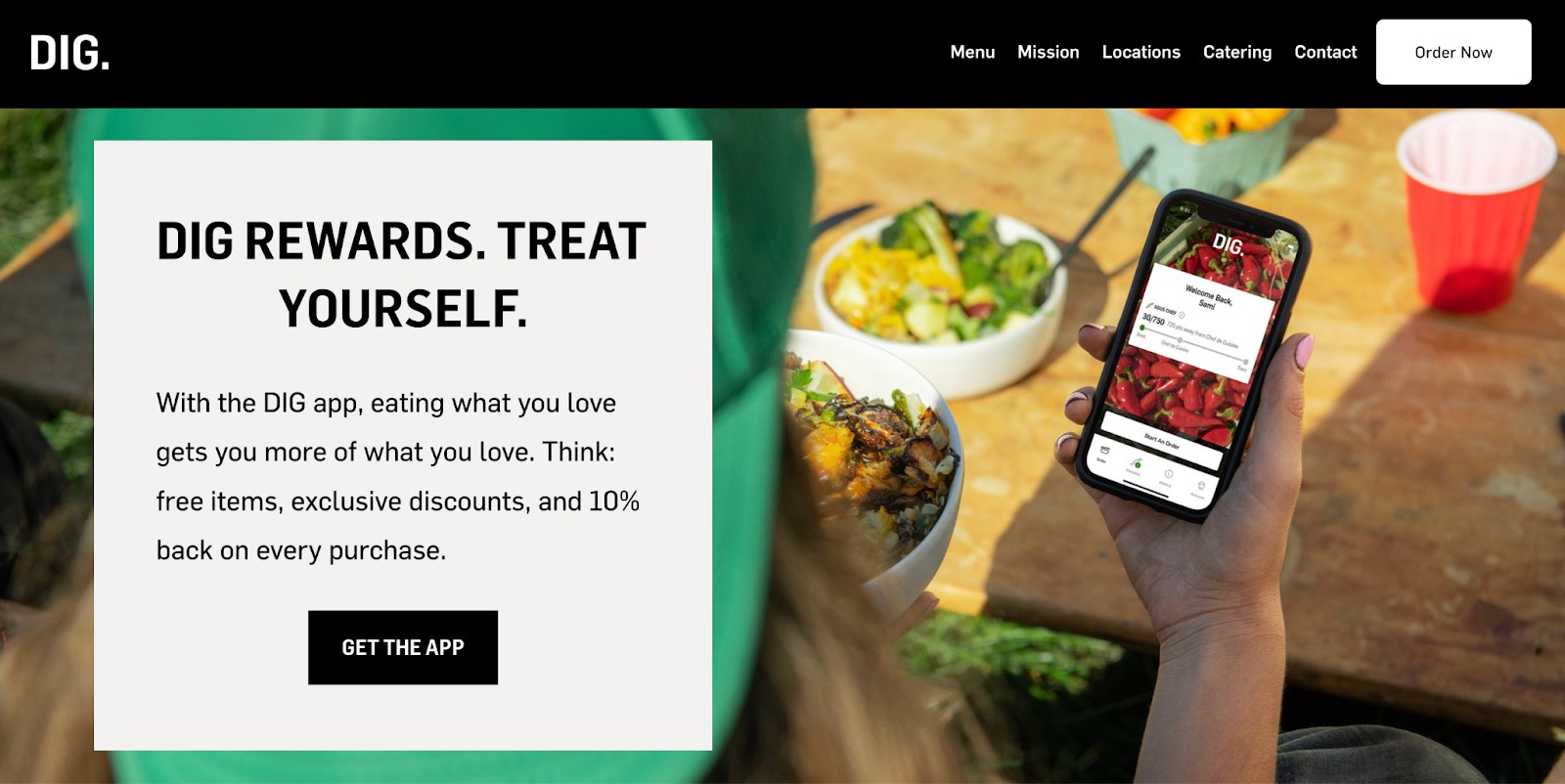
EWC Rewards
Waxing salon chain European Wax Center’s EWC Rewards program, gives members one point for every dollar spent on services and products, and 200 points for referrals. Customers can trade in 200 points for $10 in merchandise or service credit, which can be used in $10 increments.
Customers can sign up and track their progress via European Wax Center’s website or app. When EWC Rewards members make appointments while logged into their accounts, their spending is automatically tracked, so there’s no need to scan anything upon checkout, making for a smooth customer experience.
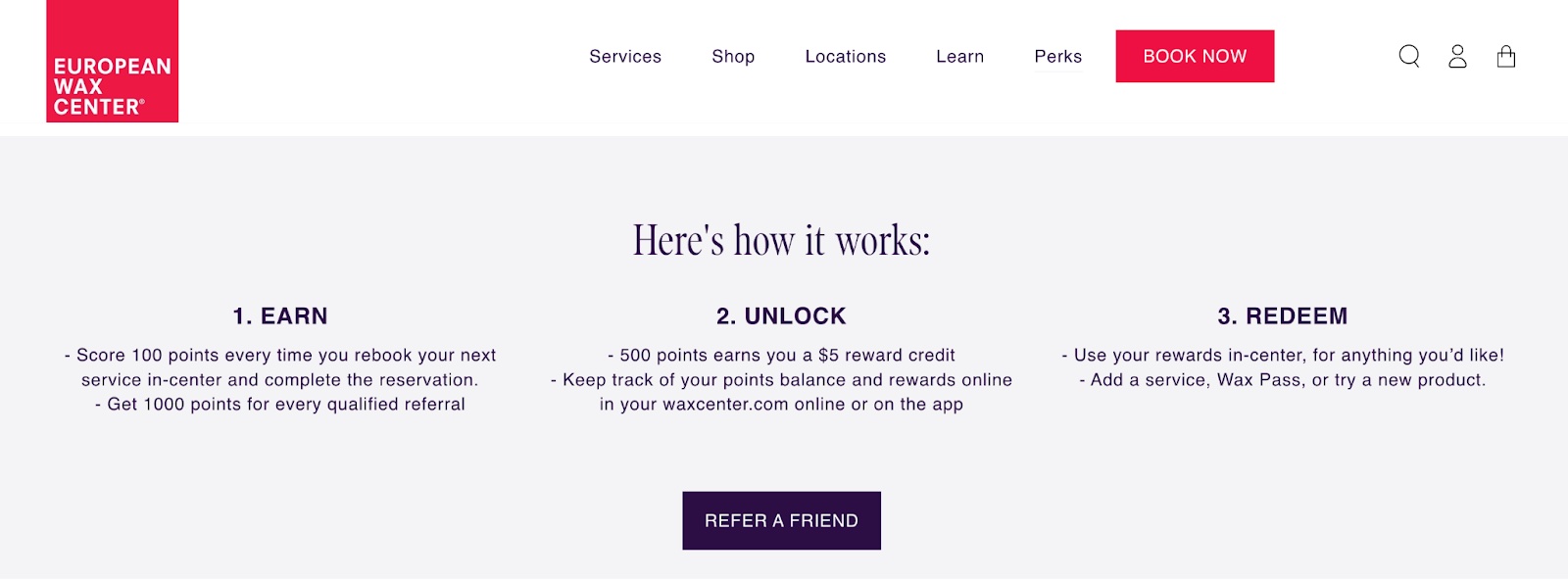
My Abercrombie Rewards
Clothing retailer Abercrombie & Fitch incentivizes repeat business through its customer rewards program My Abercrombie Rewards. Customers can join the program online, in store, or via Abercrombie’s app. New members receive 100 points just for signing up.
This rewards program has two tiers: member and VIP. Abercrombie builds customer loyalty by giving members one point for every dollar. They can redeem 2,500 points for a $10 reward. They also receive perks like access to exclusive products, special pricing and birthday and anniversary promotions. After spending $500 over their lifetime, members get upgraded to VIPs and enjoy special offers and free shipping on all online orders.
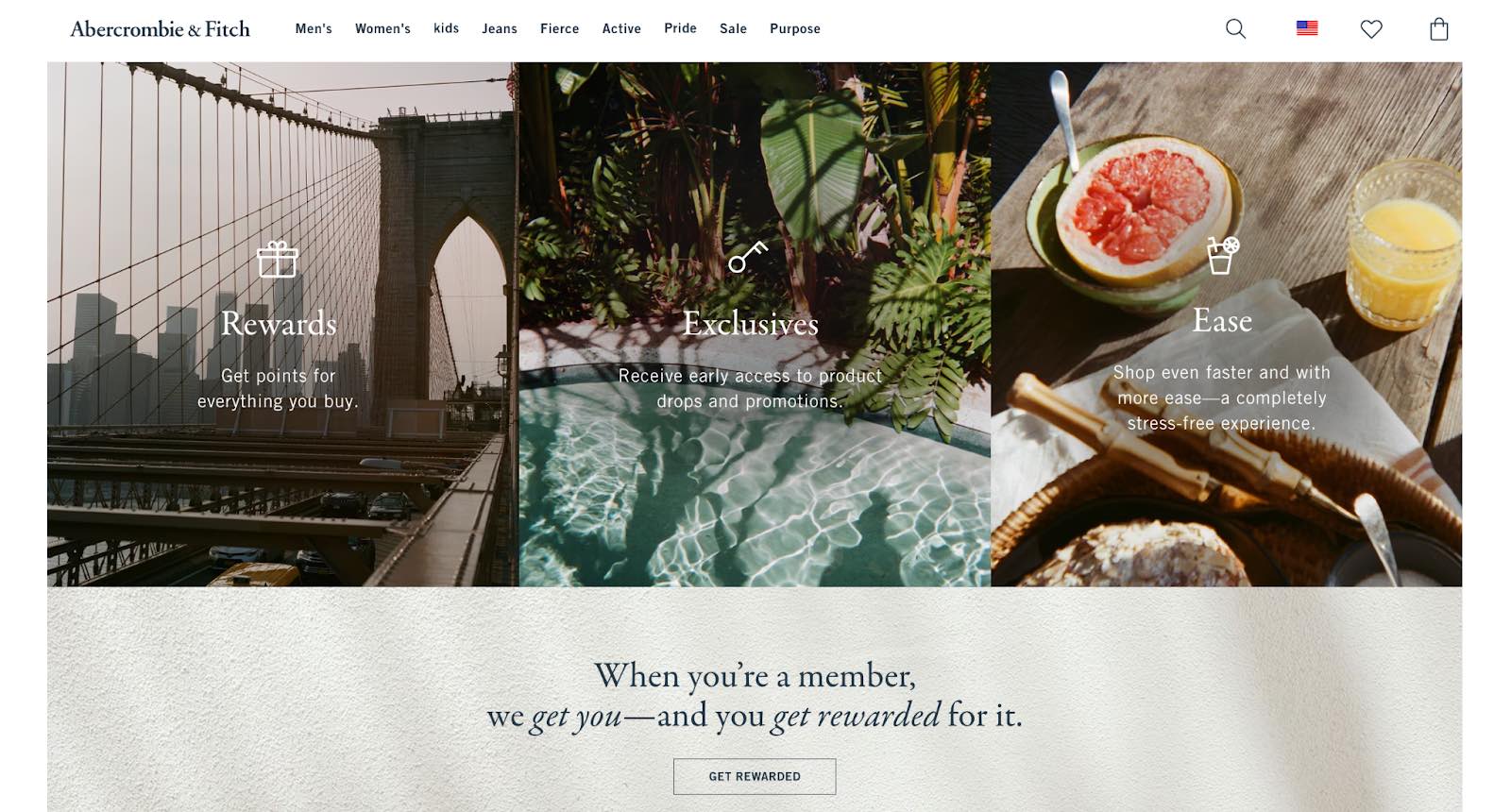
Wrapping up: Customer rewards programs for retailers
With a loyalty program, your business can incentivize repeat business, gamify shopping, gather data about customers, and much more. To create a successful program, you’ll need to choose a simple rewards structure, give customers an incentive to sign up, and make rewards attainable.
Partnering with a point of sale system that includes and integrated customer rewards program can make managing your loyalty program a piece of cake. Watch a free demo of Lightspeed today to learn how we can help you manage your entire retail business including customer rewards.

News you care about. Tips you can use.
Everything your business needs to grow, delivered straight to your inbox.



